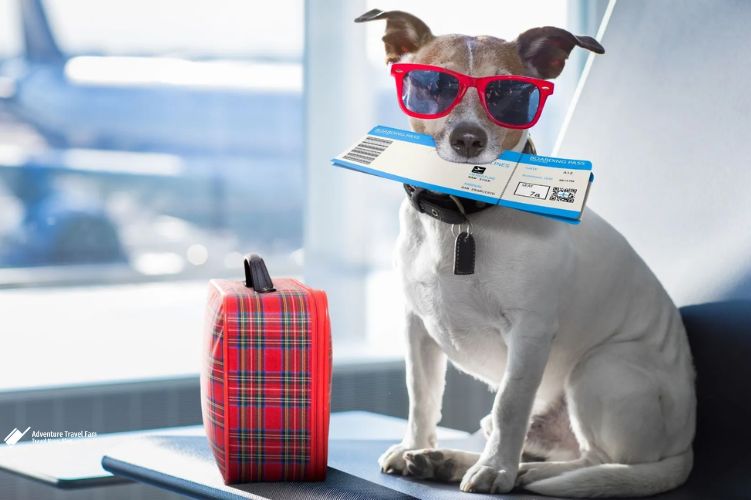As an avid traveler with my two dogs, I’ve picked up plenty of pet-friendly travel tips over the years. With 7 years of experience traversing the globe with my furry companions, I’ve learned how to make our adventures fun and stress-free. Read below about “10 Must-Know Pet-Friendly Travel Tips for Stress-Free Trips with Your Furry Friends”.
Whether you’re taking a weekend road trip or boarding a transatlantic flight, bringing your pet along requires some extra preparation and precautions. As a travel writer focusing on pet-friendly destinations, I often get asked for my best tips.
Table of Contents
10 Must-Know Pet-Friendly Travel Tips for Stress-Free Trips with Your Furry Friends
From choosing accommodations to paperwork and health concerns, here are my top 10 must-know tips for hassle-free trips with pets.
1. Research Pet Policies Thoroughly
The first and most critical step is to research the pet policies at your destination thoroughly. Every hotel, attraction, mode of transport and even city/county can have its own unique rules. For example, when traveling to San Diego last summer, I discovered that pets aren’t allowed on public buses or trolleys unless they are service animals. Had I assumed pets were allowed, I may have been refused transport or charged a fine.
Always confirm policies in writing, even if you’ve traveled there before. Requirements can change. When booking accommodations, ask about size and number restrictions, cleaning deposits, areas where pets aren’t permitted, etc. The more questions you ask upfront, the less likely you’ll encounter issues later.
2. Consider Pet Insurance
Pet insurance can be invaluable protection on trips, whether across the state or overseas. As an avid hiker, there’s always a risk my dog could get injured on the trail or eat something problematic. I once had a vet visit in Banff cost over $800 when my dog sliced his paw open. Pet insurance reimbursed 90% of the fees.
There are various tiers of coverage for emergency visits, prescriptions, exams, etc. I use Pawlicy Advisor to compare plans and rates. For frequent travelers, accident/injury coverage is essential. Some insurers even cover trip cancellation costs if your pet gets sick pre-departure.
3. Pack a Pet First Aid Kit
In addition to pet insurance, I always travel with a pet first aid kit. At minimum, it should contain gauze, bandages, tweezers, scissors, antibiotic ointment, Benadryl, saline eye/wound wash, latex gloves, thermometer, and electrolyte supplements. I also include contact info for nearby 24-hour emergency vets at each destination.
Having supplies on hand can buy you time to get to a vet, especially on remote adventures. On a recent camping trip, my dog got stung by a bee. I was able to administer Benadryl right away to ease swelling before driving into town. Prepare for the most likely emergencies your breed may face. For example, short-nosed dogs are prone to overheating and winter breeds to frostbite.
4. Get an ID Tag with Current Info
An ID tag with your current contact information is essential in case your pet gets lost. The tag should include your name, mobile number, home address, email address, and alternative emergency contact. I order custom engraved tags from Boomerang Tags with all these details.
Some pet parents also opt for a microchip or GPS collar. While useful additions, they shouldn’t replace an ID tag which is visible to anyone who finds your pet. Upon arriving to any lodging, I immediately confirm contact details with the front desk too.
5. Master Travel Documentation

From health certificates to crossing borders, documentation requirements for pets can be complex. Thoroughly research regulations for each destination and mode of transport. For example, flying internationally always requires a veterinary health certificate from within 10 days of departure. Some countries even mandate rabies titers.
Always work with your vet to ensure you have the proper paperwork. Confirm timing regulations too. For instance, Puerto Rico requires the certificate to be completed by a USDA-accredited vet no more than 5 days pre-departure. I maintain a checklist of documentation requirements for common destinations to ensure I don’t miss any.
6. Get Proper Vaccinations & Preventatives
Vaccination and parasite prevention requirements vary significantly depending on your destination. With my veterinarian’s guidance, I plan these treatments out months in advance. Some injections or preventatives take weeks to become fully effective.
For example, the rabies vaccine takes 21 days to reach immunity – which is essential for crossing certain borders. Some countries even require the rabies titer test 1-2 months post-vaccination too. Talk to your vet about destination-specific risks and best practices. Having proof of treatments is also key for border crossings.
7. Practice Good Plane & Hotel Etiquette
Traveling with pets means considering those around you. Practice proper etiquette, especially regarding barking, accidents, and cleanliness. I always book direct flights under 5 hours to minimize hassle for all. Upon airport arrival, I immediately take my dogs outside to relieve themselves.
I also request rooms on high floors, ideally with balcony access for potty breaks. While most hotels charge cleaning fees for accidents, preventing them in the first place is best practice. Bringing potty pads, deodorizing spray, waste bags, paper towels and stain/odor remover is smart too. Thoroughly cleaning areas soiled by urine, feces or vomit is essential.
https://www.instagram.com/romingotravel/p/C-70FkftXDI
8. Pack Familiar Items & Toys
To ease anxiety for pets, packing familiar items is key. I always bring my dogs’ favorite toys, treats, beds and bowls. Maintaining consistent mealtimes also helps minimize stomach issues. While travel is exciting, changes in environment, schedule and diet can cause upset.
If your pet has severe anxiety, discuss medication options with your vet. Sedatives, natural calming aids and pheromone collars can help certain pets relax. Getting pets accustomed to car travel when young is ideal too. However even senior dogs can learn to enjoy road trips with time and positive associations.
9. Handle Temperature Extremes with Care
Knowing how to maintain safe temperatures for your pet is crucial on trips. Short-nosed dogs prone to overheating require extra vigilance on warm days or in hot climates. As an English Bulldog owner, I monitor temperature diligently, stay in pet-friendly and air-conditioned accommodations, avoid extensive outdoor time in heat, and always have water available.
On the other end of the spectrum, small or thin-coated breeds like Chihuahuas struggle in the cold. Having a sweater or coat on hand is essential. When camping or hiking in winter, I establish temperature limits based on my dogs’ comfort levels. If they start shivering, it’s time to warm up indoors. Extremes can escalate to hypothermia or heat stroke fast so diligence is vital.
10. Scout Pet-Friendly Attractions
Finding pet-friendly attractions maximizes enjoyment. I always research dog parks, trails, beaches, patio restaurants and stores ahead of time. I’ve also discovered certain outdoor malls and home improvement stores permit pets – a great option when running errands.
Many hotels also provide dog walking routes or pet amenities like treats, toys and relief areas. Take advantage of these or ask the concierge for recommendations. Avoid leaving pets unattended in rooms for prolonged periods. With proper planning, pets can safely join in many vacation adventures and outings without being left behind in a hotel room solo.
Conclusion
Bringing pets on trips requires effort but pays off through unforgettable shared adventures. While extra diligence is required, preparation goes a long way towards stress-free travels with your furry companions. Do ample research, packing and planning ahead of time and you’ll have peace of mind. These tips have worked wonderfully for me over the years and I hope they inspire you to hit the road or skies with your favorite pet! I hope you like reading “10 Must-Know Pet-Friendly Travel Tips for Stress-Free Trips with Your Furry Friends”.

Sophie Turner is the adventure travel writer behind AdventureTravelFam.com. With over 10 years of experience in travel writing and a Master’s degree in Tourism Management, Sophie shares her expertise in exploring unique destinations and providing family-friendly travel tips. Follow her adventures on Instagram @adventure_travelfamily.





